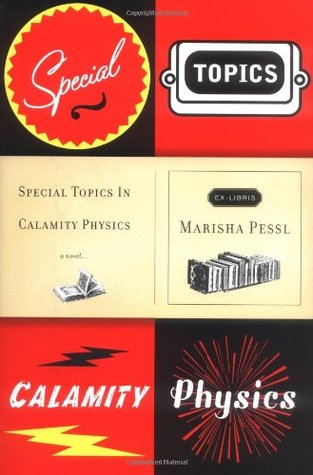 This one took me nearly three weeks, which is almost unprecedented. It was also surprising, considering how much I loved Night Film, a book by the same author.
This one took me nearly three weeks, which is almost unprecedented. It was also surprising, considering how much I loved Night Film, a book by the same author.
Special Topics in Calamity Physics has nothing to do with physics, rest assured. Rather, it follows the first person account of Blue Van Meer, a senior in high school who is burdened by 1) her profound intellect, and 2) her profound social discomfort. She has been raised by her father single-handedly (her mother died when Blue was five), and they’ve traipsed the country chasing one collegiate job after another. Gareth Van Meer is a brilliant man who his coveted by this university and that institution and Blue has been along for the ride.
For her senior year they settle in a small North Carolina town where Blue attends an elite private school. She gets collected by a charming film teacher, Hannah, who has a secret club of sorts for her favorite students. (Think Professor Slughorn.) The students in her little group are not a delight but rather they each possess qualities that puts Blue off, leaving her uncomfortable, confused as to why she’s been included (Veronica from Heathers).
Yet, she continues to meet the group at Hannah’s house. They drink, they smoke, Blue slowly meshes – but only to a point. Ever present is enthralling Hannah, the enigma, the curious creature who defies human nature. She is the magnet that keeps the students tightly entwined. (see Dead Poets Society).
Then, about 300 pages in, Blue finds Hannah dead. I’m not spoiling anything here, for this detail is mentioned on the back of the book description. I mention it now because it takes readers more than 300 pages to get to the part where things finally get interesting enough to suck you in. It was so intriguing that I finished the last 200 pages in three days. (Did you do the math there? The book is 500 pages long.)
It’s here that I argue that the book could’ve been 300 pages at the most had the fat been trimmed. What’s the fat? Tangents. Many, many tangents, or as I’ve called them, speed bumps. You’ll be trucking along in a steady narrative, at a decent speed, and then – almost abruptly – you reach a speed bump that ultimately slows you down.
What are the speed bumps? I’ve given you the briefest glimpse of them in this post: outside references. Where I’ve only mentioned three, Pessl mentions dozens. Gosh, hundreds even. Every paragraph is riddled with references to this paper or that movie or a certain book that’s supposed to paint a clearer picture of the scene. You go into this book already knowing the murder will happen, but GOOD GRACIOUS it takes forever to get there. And while the references are clever and carefully selected, there are just too many.
It might surprised you to know that, in the end, I liked the book. The conclusion is a work of magic, the sort of magic that made me love Night Film. It almost makes me forget that it took three weeks to reach the conclusion.
I read a few reviews of this book because I wanted to know what the high brows thought of it. I couldn’t find a bad review, but I found plenty of remarks to the ambition of it, the overworked metaphors and the painfully obvious need Pessl felt to prove herself with such a debut. “If only she hadn’t tried so hard,” one critic said. I agree.
The book is good. The plot is damn good. But wow, she could’ve pulled it back a bit.
